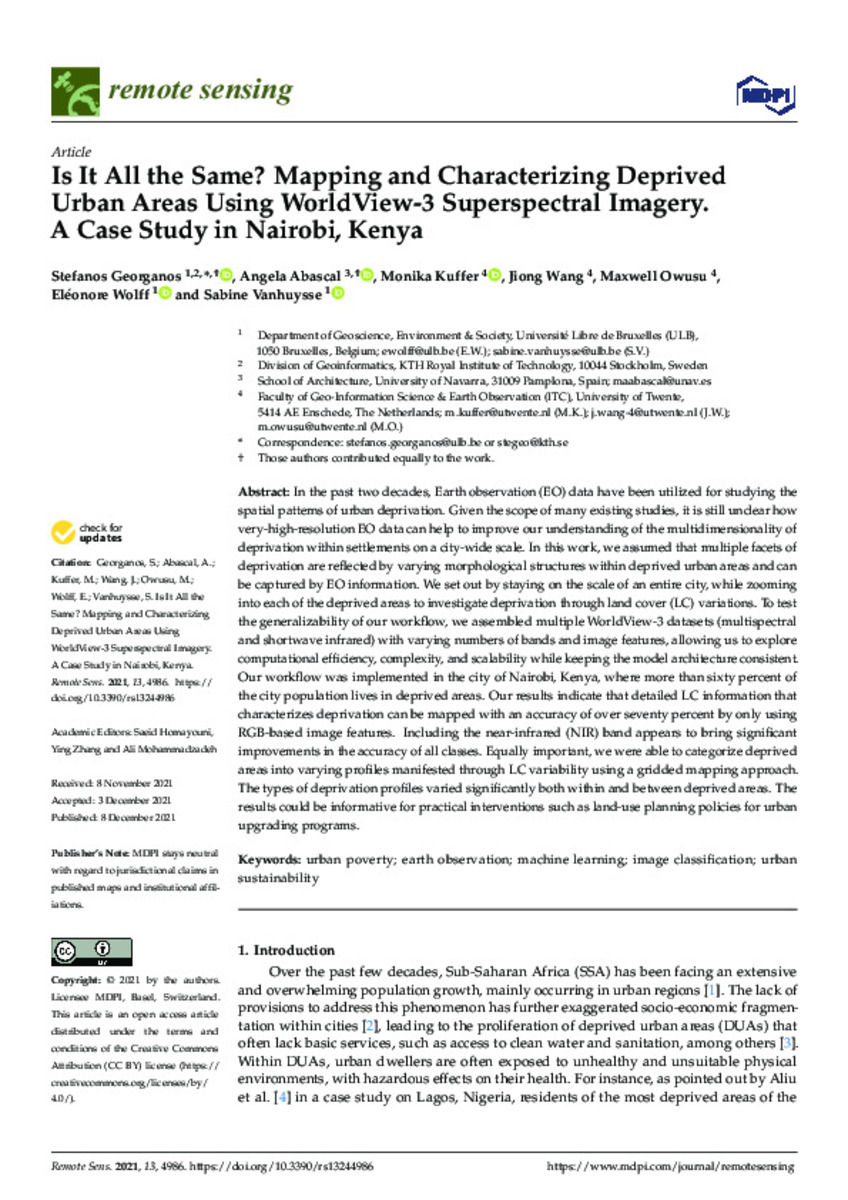Full metadata record
| DC Field | Value | Language |
|---|---|---|
| dc.creator | Georganos, S. (Stefanos) | - |
| dc.creator | Abascal, Á. (Ángela) | - |
| dc.creator | Kuffer, M. (Monika) | - |
| dc.creator | Wang, J. (Jiong) | - |
| dc.creator | Owusu, M. (Maxwell) | - |
| dc.creator | Wolff, E. (Eléonore) | - |
| dc.creator | Vanhuysse, S. (Sabine) | - |
| dc.date.accessioned | 2022-01-27T08:51:07Z | - |
| dc.date.available | 2022-01-27T08:51:07Z | - |
| dc.date.issued | 2021 | - |
| dc.identifier.citation | Georganos S, Abascal A, Kuffer M, Wang J, Owusu M, Wolff E, Vanhuysse S. Is It All the Same? Mapping and Characterizing Deprived Urban Areas Using WorldView-3 Superspectral Imagery. A Case Study in Nairobi, Kenya. Remote Sensing. 2021; 13(24):4986. | es_ES |
| dc.identifier.issn | 2072-4292 | - |
| dc.identifier.uri | https://hdl.handle.net/10171/62848 | - |
| dc.description.abstract | In the past two decades, Earth observation (EO) data have been utilized for studying the spatial patterns of urban deprivation. Given the scope of many existing studies, it is still unclear how very-high-resolution EO data can help to improve our understanding of the multidimensionality of deprivation within settlements on a city-wide scale. In this work, we assumed that multiple facets of deprivation are reflected by varying morphological structures within deprived urban areas and can be captured by EO information. We set out by staying on the scale of an entire city, while zooming into each of the deprived areas to investigate deprivation through land cover (LC) variations. To test the generalizability of our workflow, we assembled multiple WorldView-3 datasets (multispectral and shortwave infrared) with varying numbers of bands and image features, allowing us to explore computational efficiency, complexity, and scalability while keeping the model architecture consistent. Our workflow was implemented in the city of Nairobi, Kenya, where more than sixty percent of the city population lives in deprived areas. Our results indicate that detailed LC information that characterizes deprivation can be mapped with an accuracy of over seventy percent by only using RGB-based image features. Including the near-infrared (NIR) band appears to bring significant improvements in the accuracy of all classes. Equally important, we were able to categorize deprived areas into varying profiles manifested through LC variability using a gridded mapping approach. The types of deprivation profiles varied significantly both within and between deprived areas. The results could be informative for practical interventions such as land-use planning policies for urban upgrading programs. | es_ES |
| dc.language.iso | eng | es_ES |
| dc.publisher | MDPI | es_ES |
| dc.rights | info:eu-repo/semantics/openAccess | es_ES |
| dc.subject | Urban poverty | es_ES |
| dc.subject | Earth observation | es_ES |
| dc.subject | Machine learning | es_ES |
| dc.subject | Image classification | es_ES |
| dc.subject | Urban sustainability | es_ES |
| dc.title | Is it all the same? Mapping and characterizing deprived urban areas using worldView-3 superspectral imagery. A case study in Nairobi, Kenya | es_ES |
| dc.type | info:eu-repo/semantics/article | es_ES |
| dc.editorial.note | This is an open access article distributed under the Creative Commons Attribution License which permits unrestricted use, distribution, and reproduction in any medium, provided the original work is properly cited | es_ES |
| dc.identifier.doi | 10.3390/rs13244986 | - |
Files in This Item:
Statistics and impact
Items in Dadun are protected by copyright, with all rights reserved, unless otherwise indicated.






